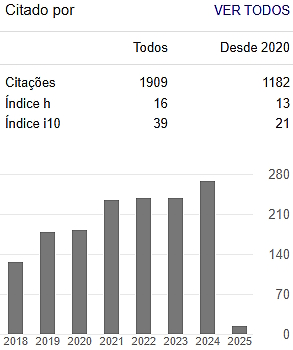JUICIO MORAL DE ESTUDIANTES Y MAESTROS ANTE HECHOS DE VIOLENCIA EN UNA ESCUELA SECUNDARIA PÚBLICA EN MÉXICO
Keywords:
violence, moral judgment, secondary students, sanctions, MexicoAbstract
The objective of the investigation of violent events in the daily settings of high school students in Mexico was to reveal them as part of a training process for their teachers. From the conception that social and school violence are inherent to the social order and are expressed in bodies and things, our interdisciplinary approach, based on a mixed methodology, sought to unravel the moral judgment of students and adults in correspondence with these events, which have been mainly fights and beatings, harassment and robbery. Interventions regarding adults, in accordance with school regulations, have been the predominant application of expiatory sanctions, or their inaction, thus adding other forms of violence that express a heteronomous moral judgment. This forces most students to be careful not to fall for provocations from the other minority group, willing to attack them as a way to settle their differences. Also the moral judgment of the students is heteronomous and their proposals to face these facts, to a large extent, coincide with the school regulations. However, a minority group of students proposed, in addition to listening, empathy and dialogue, that they “favor their own behaviors among equals”, which is the law of true cooperation, suggestive for a formative process of adults that facilitates the transition towards a moral judgment of cooperation, for a coexistence of protection and a better teaching-learning process.
Downloads
References
CASTILLO, C.; PACHECO, M. Perfil del maltrato (Bullying) entre estudiantes de Secundaria en la Ciudad de Mérida, Yucatán. Revista Mexicana de Investigación Educativa, vol. 13, (38),825-842.México, 2008.
COLOMBO, G. Violencia escolar y convivencia escolar: Descubriendo estrategias en la vida cotidiana. Revista Argentina de Sociología, 8-9 (15-16), 81-104. Buenos Aires, 2011.
ELÍAS, N. El proceso de la civilización. Investigaciones sociogenéticas y psicogenéticas. México: Fondo de Cultura Económica,1998.
FRACCHIA, M. Propuesta de un enfoque basado en aportes sociopsicogenéticos para la formación en investigación-intervención sobre la relación entre violencia escolar y violencia social. En Velázquez, G. El paradigma de la complejidad y la investigación de los problemas sociales, educativos y culturales del siglo XXI. México: Universidad Pedagógica Nacional, 2018.
FURLAN, A. Convivencia, disciplina y violencia en las escuelas. Revista Mexicana de Investigación Educativa. México: COMIE,2003.
FURLAN, A. Reflexiones sobre la violencia en las escuelas. México: Siglo XXI, 2013.
GARCÍA SALORD, S. “La violencia simbólica: aportación de Pierre Bourdieu para comprender las formas sutiles e inadvertidas de dominación” en FURLÁN,A. Reflexiones sobre la violencia en las escuelas. México:Siglo XXI,pp. 114-143, 2012.
GUTIÉRREZ, A. Las prácticas sociales: una introducción a Pierre Bourdieu. Córdoba; Ferreyra Editor,2005.
GUTIÉRREZ, A. “Poder, hábitus y representaciones: recorrido por el concepto de violencia simbólica en Pierre Bourdieu”.Revista Complutense de la Educación, Vol. 15 Núm. PP. 289-3000. ISSN:1130-2496,2004
KLOSTER,K.; FRACCHIA,M. El costo humano en la construcción de los dominios territoriales, en KLOSTER,K.(coord.) Conflictividad y violencias en América Latina (pp. 229-264).Ciudad de México: UACM, 2017.
MALDONADO, S. La escuela como territorio de intervención política. Buenos Aires: Gráfica Alsina,2004.
MARÍN, J.C.Prólogo. Pensar en voz alta. En Muleras, E. Conocimiento y sociedad (pp.13-25). Buenos Aires: Ed. P.I.Ca.So.,2005.
MARÍN, J.C. Conversaciones sobre el poder. Buenos Aires: Universidad de Buenos Aires, 1995.
LÓPEZ, M.; SAÑUDO, L.; MAGGI, R. (coords). Investigaciones sobre la investigación educativa 2002-2011. México: ANUIES, Dirección de Medios Editoriales: Consejo Mexicano de Investigación Educativa. (Colección Estados del Conocimiento),2013.
OLWEUS, D. Conductas de acoso y amenaza entre escolares. Madrid: Morata, 1998.
OVIEDO, D.; FRACCHA, M. Estado de la cuestión en torno a las violencias en las escuelas. Revista Educación, Formación e Investigación, Vol. 4, N.7, ISSN 2422-5975 (en línea), diciembre de 2018.
PIAGET, J. Introducción a la epistemología genética. La explicación sociológica. Tomo III. Buenos Aires: Paidós, 1975.
PIAGET, J. El criterio moral en el niño. México, Ed. Roca,1985.
POUJOL, G.; FRACCHIA, M. Efectos sociales y educativos de la violencia escolar en una secundaria pública en Morelos. Revista Polisemia, 22, pp.91-105. Bogotá: Corporación Universitaria Minuto de Dios-UNIMINUTO,2017.
SAUCEDO, C. y GUZMÁN, C. La investigación sobre la violencia escolar en México: tendencias, tensiones y desafíos. Revista Cultura y Representaciones Sociales,12(24),213-245, 2018. Disponible en: http://www.culturayrs.org.mx/index.php/CRS/article/view/472
SPOSITO, M. Um breve equilíbrio da pesquisa sobre violencia escolar no Brasil. En: Revista Educacao e Pesquisa, v. 27,(1), 87-103, Sao Paulo: USP, 2001.

